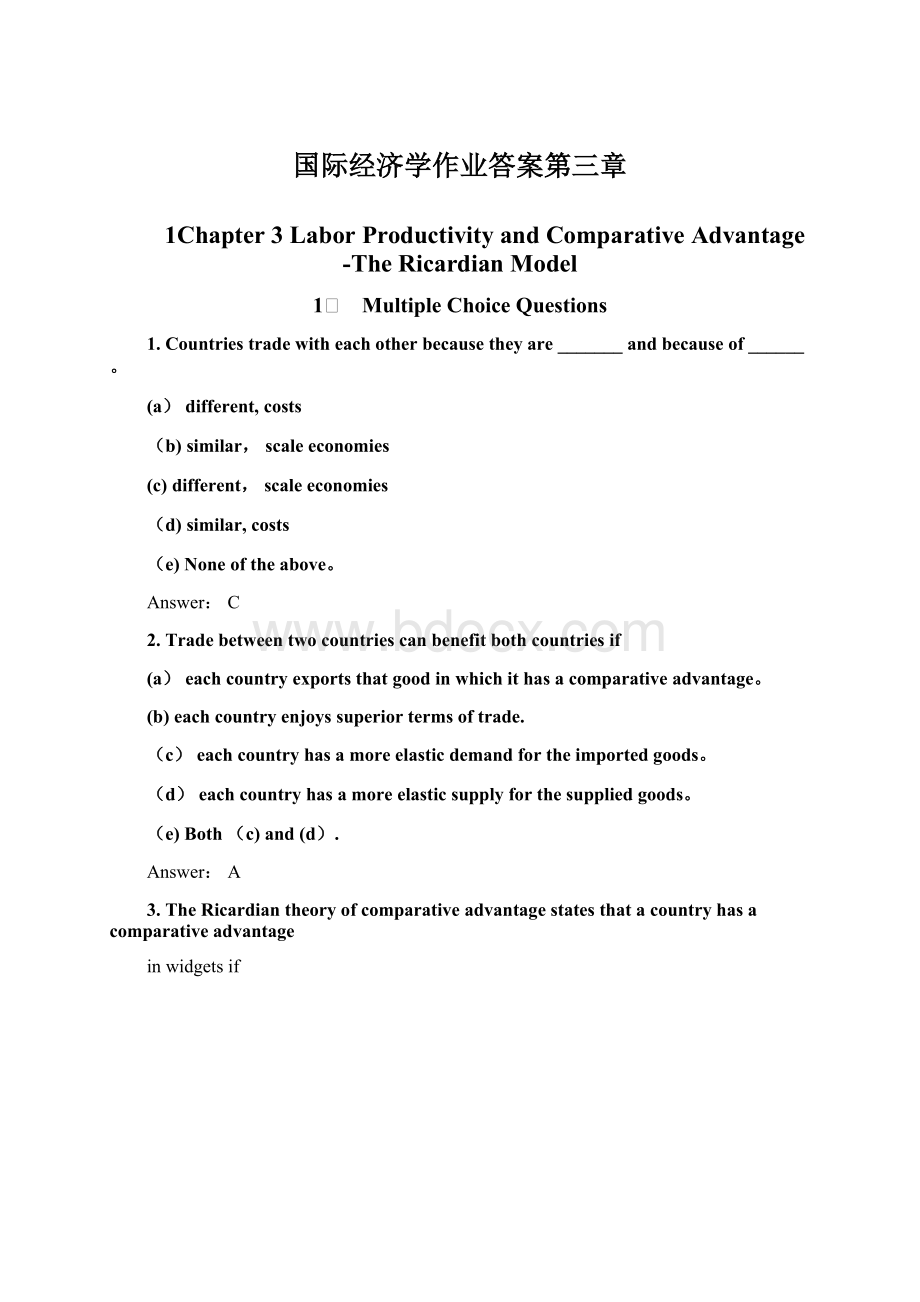国际经济学作业答案第三章.docx
《国际经济学作业答案第三章.docx》由会员分享,可在线阅读,更多相关《国际经济学作业答案第三章.docx(22页珍藏版)》请在冰豆网上搜索。

国际经济学作业答案第三章
1Chapter3LaborProductivityandComparativeAdvantage-TheRicardianModel
1⏹ MultipleChoiceQuestions
1.Countriestradewitheachotherbecausetheyare_______andbecauseof______。
(a)different,costs
(b)similar,scaleeconomies
(c)different,scaleeconomies
(d)similar,costs
(e)Noneoftheabove。
Answer:
C
2.Tradebetweentwocountriescanbenefitbothcountriesif
(a)eachcountryexportsthatgoodinwhichithasacomparativeadvantage。
(b)eachcountryenjoyssuperiortermsoftrade.
(c)eachcountryhasamoreelasticdemandfortheimportedgoods。
(d)eachcountryhasamoreelasticsupplyforthesuppliedgoods。
(e)Both(c)and(d).
Answer:
A
3.TheRicardiantheoryofcomparativeadvantagestatesthatacountryhasacomparativeadvantage
inwidgetsif
(a)outputperworkerofwidgetsishigherinthatcountry。
(b)thatcountry’sexchangerateislow。
(c)wageratesinthatcountryarehigh。
(d)theoutputperworkerofwidgetsascomparedtotheoutputofsomeotherproductishigherinthatcountry.
(e)Both(b)and(c).
Answer:
D
4。
Inordertoknowwhetheracountryhasacomparativeadvantageintheproductionofoneparticularproductweneedinformationonatleast____unitlaborrequirements
(a)one
(b)two
(c)three
(d)four
(e)five
Answer:
D
5。
Acountryengagingintradeaccordingtotheprinciplesofcomparativeadvantagegainsfromtradebecauseit
(a)isproducingexportsindirectlymoreefficientlythanitcouldalternatively.
(b)isproducingimportsindirectlymoreefficientlythanitcoulddomestically。
(c)isproducingexportsusingfewerlaborunits.
(d)isproducingimportsindirectlyusingfewerlaborunits.
(e)Noneoftheabove.
Answer:
B
6.Giventhefollowinginformation:
UnitLaborRequirements
Cloth
Widgets
Home
10
20
Foreign
60
30
(a)Neithercountryhasacomparativeadvantage。
(b)Homehasacomparativeadvantageincloth.
(c)Foreignhasacomparativeadvantageincloth.
(d)Homehasacomparativeadvantageinwidgets。
(e)Homehasacomparativeadvantageinbothproducts.
Answer:
B
7.IfitisascertainedthatForeignusesprison—slavelabortoproduceitsexports,thenhomeshould
(a)exportcloth。
(b)exportwidgets.
(c)exportbothandimportnothing.
(d)exportandimportnothing。
(e)Alloftheabove。
Answer:
A
8.IftheHomeeconomysufferedameltdown,andtheUnitLaborRequirementsineachoftheproductsquadrupled(thatis,doubledto30forclothand60forwidgets)thenhomeshould
(a)exportcloth.
(b)exportwidgets.
(c)exportbothandimportnothing.
(d)exportandimportnothing。
(e)Alloftheabove.
Answer:
A
9。
IfwagesweretodoubleinHome,thenHomeshould:
(a)exportcloth.
(b)exportwidgets.
(c)exportbothandimportnothing.
(d)exportandimportnothing。
(e)Alloftheabove。
Answer:
A
10。
Iftheworldequilibriumpriceofwidgetswere4Cloths,then
(a)bothcountriescouldbenefitfromtradewitheachother。
(b)neithercountrycouldbenefitfromtradewitheachother.
(c)eachcountrywillwanttoexportthegoodinwhichitenjoyscomparativeadvantage.
(d)neithercountrywillwanttoexportthegoodinwhichitenjoyscomparativeadvantage.
(e)bothcountrieswillwanttospecializeincloth。
Answer:
A
11。
Giventhefollowinginformation:
NumberofUnitsProducedbyoneUnitofLabor
Cloth
Widgets
Home
10
20
Foreign
60
30
(a)Neithercountryhasacomparativeadvantage.
(b)Homehasacomparativeadvantageincloth.
(c)Foreignhasacomparativeadvantageincloth.
(d)Foreignhasacomparativeadvantageinwidgets。
(e)Homehasacomparativeadvantageinbothproducts.
Answer:
C
12.TheopportunitycostofclothintermsofwidgetsinForeignisifitisascertainedthatForeignusesprison-slavelabortoproduceitsexports,thenhomeshould
(a)exportcloth.
(b)exportwidgets。
(c)exportbothandimportnothing.
(d)exportandimportnothing。
(e)Alloftheabove。
Answer:
B
13。
IfwagesweretodoubleinHome,thenHomeshould
(a)exportcloth。
(b)exportwidgets.
(c)exportbothandimportnothing.
(d)exportandimportnothing.
(e)Alloftheabove.
Answer:
B
14.Iftheworldequilibriumpriceofwidgetswere4Cloths,then
(a)bothcountriescouldbenefitfromtradewitheachother.
(b)neithercountrycouldbenefitfromtradewitheachother。
(c)eachcountrywillwanttoexportthegoodinwhichitenjoyscomparativeadvantage。
(d)neithercountrywillwanttoexportthegoodinwhichitenjoyscomparativeadvantage.
(e)bothcountrieswillwanttospecializeincloth。
Answer:
A
15。
Iftheworldequilibriumpriceofwidgetswere40cloths,then
(a)bothcountriescouldbenefitfromtradewitheachother。
(b)neithercountrycouldbenefitfromtradewitheachother。
(c)eachcountrywillwanttoexportthegoodinwhichitenjoyscomparativeadvantage.
(d)neithercountrywillwanttoexportthegoodinwhichitenjoyscomparativeadvantage.
(e)bothcountrieswillwanttospecializeincloth.
Answer:
A
16.Inatwoproducttwocountryworld,internationaltradecanleadtoincreasesin
(a)consumerwelfareonlyifoutputofbothproductsisincreased。
(b)outputofbothproductsandconsumerwelfareinbothcountries。
(c)totalproductionofbothproductsbutnotconsumerwelfareinbothcountries。
(d)consumerwelfareinbothcountriesbutnottotalproductionofbothproducts。
(e)Noneoftheabove
Answer:
B
17.Asaresultoftrade,specializationintheRicardianmodeltendstobe
(a)completewithconstantcostsandwithincreasingcosts。
(b)completewithconstantcostsandincompletewithincreasingcosts.
(c)incompletewithconstantcostsandcompletewithincreasingcosts.
(d)incompletewithconstantcostsandincompletewithincreasingcosts.
(e)Noneoftheabove。
Answer:
B
18.Asaresultoftradebetweentwocountrieswhichareofcompletelydifferenteconomicsizes,specializationintheRicardian2X2modeltendstobe
(a)incompleteinbothcountries
(b)completeinbothcountries
(c)completeinthesmallcountrybutincompleteinthelargecountry
(d)completeinthelargecountrybutincompleteinthesmallcountry
(e)Noneoftheabove
Answer:
C
19.AnationengagingintradeaccordingtotheRicardianmodelwillfinditsconsumptionbundle
(a)insideitsproductionpossibilitiesfrontier.
(b)onitsproductionpossibilitiesfrontier.
(c)outsideitsproductionpossibilitiesfrontier.
(d)insideitstrade-partner'sproductionpossibilitiesfrontier。
(e)onitstrade—partner’sproductionpossibilitiesfrontier.
Answer:
C
20。
IntheRicardianmodel,ifacountry’stradeisrestricted,thiswillcauseallexceptwhich?
(a)Limitspecializationandthedivisionoflabor.
(b)Reducethevolumeoftradeandthegainsfromtrade
(c)Causenationstoproduceinsidetheirproductionpossibilitiescurves
(d)Mayresultinacountryproducingsomeoftheproductofitscomparativedisadvantage
(e)Noneoftheabove.
Answer:
C
21.IfaverysmallcountrytradeswithaverylargecountryaccordingtotheRicardianmodel,then
(a)thesmallcountrywillsufferadecreaseineconomicwelfare.
(b)thelargecountrywillsufferadecreaseineconomicwelfare.
(c)thesmallcountryonlywillenjoygainsfromtrade.
(d)thelargecountrywillenjoygainsfromtrade.
(e)Noneoftheabove。
Answer:
C
22.IftheworldtermsoftradeforacountryaresomewherebetweenthedomesticcostratioofHandthatofF,then
(a)countryHbutnotcountryFwillgainfromtrade。
(b)countryHandcountryFwillbothgainfromtrade。
(c)neithercountryHnorFwillgainfromtrade.
(d)onlythecountrywhosegovernmentsubsidizesitsexportswillgain.
(e)Noneoftheabove.
Answer:
B
23.IftheworldtermsoftradeequalthoseofcountryF,then
(a)countryHbutnotcountryFwillgainfromtrade.
(b)countryHandcountryFwillbothgainfromtrade。
(c)neithercountryHnorFwillgainfromtrade.
(d)onlythecountrywhosegovernmentsubsidizesitsexportswillgain.
(e)Noneoftheabove.
Answer:
A
24.Iftheworldtermsoftradeequalthoseofcountry,Fthen
(a)countryHbutnotcountryFwillgainfromtrade.
(b)countryHandcountryFwillbothgainfromtrade。
(c)neithercountryHnorFwillgainfromtrade。
(d)onlythecountrywhosegovernmentsubsidizesitsexportswillgain.
(e)Noneoftheabove。
Answer:
E
25。
Ifaproductionpossibilitiesfrontierisbowedout(concavetotheorigin),thenproductionoccursunderconditionsof
(a)constantopportunitycosts。
(b)increasingopportunitycosts。
(c)decreasingopportunitycosts.
(d)infiniteopportunitycosts.
(e)Noneoftheabove。
Answer:
B
26.Iftheproductionpossibilitiesfrontierofonethetradepartners(“CountryA")isbowedout(concavetotheorigin),thenincreasedspecializationinproductionbythatcountrywill
(a)Increasetheeconomicwelfareofbothcountries。
(b)IncreasetheeconomicwelfareofonlyCountryA。
(c)DecreasetheeconomicwelfareofCountryA。
(d)DecreasetheeconomicwelfareofCountryB.
(e)Noneoftheabove.
Answer:
A
27.Iftwocountrieshaveidenticalproductionpossibilityfrontiers,thentradebetweenthemisnotlikelyif
(a)theirsupplycurvesareidentical。
(b)theircostfunctionsareidentical.
(c)theirdemandconditionsidentical。
(d)theirincomesareidentical.
(e)Noneoftheabove。
Answer:
E
28.Iftwocountrieshaveidenticalproductionpossibilityfrontiers,thentradebetweenthemisnotlikelyif
(a)theirsupplycurvesareidentical。
(b)theircostfunctionsareidentical.
(c)theirdemandfunctionsdiffer。
(d)theirincomesareidentical。
(e)Noneoftheabove。
Answer:
C
29.Theearlieststatementoftheprincipleofcomparativeadvan